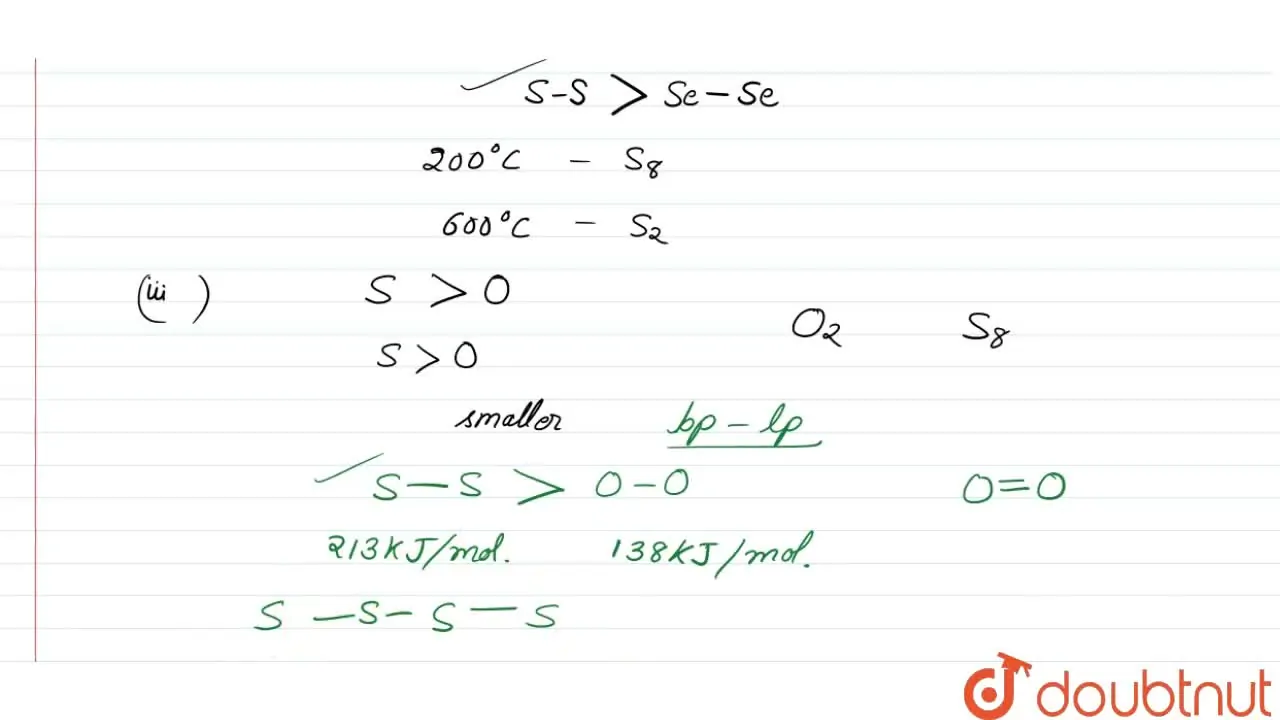Give reasons for the following observations :
Why SF4 undergoes hydrolysis but not SF6?
Or SF6 is inert towards hydroysis.
SF6 is much less reactive than SF4.
Or (i) SF4 is easily hydrolysed whereas SF6 is not easily hydrolysed.
(ii) Sulpher exhibits greater tendency for calenation than selenium.
(iii) Sulpher has a higher tendency for catenation than oxygen.
(i) In SF6,S is stericallly protected by six F atoms and hence does not allow H2O molecules to attack the S atom. Furthermore, F does not have d-orbitals to accept the electrons donated bt H2O molecules. As a since it is surrounded by only four F atoms. As a result, attack of H2O moleucles on S atom can take place easily and hence htdroysis occurs.
(ii) As we move from S to Se, the atomic size increases and hence the strength of E-E bond decreases. As a result, S-S bond is much stronger than Se-Se bond and consequently, S shows greater tendency for catendation than selenium.
(iii) Due to Small size, the lone pairs of electrons on the O atoms repel the bond pair of the O-O bond to a greater extend that the lone pairs of electrons on the S atom in S-S bond. As a result, S-S bond is much stronger (213kJmol−1) than O-O bond (138kJmol−1) and hence S has a much stornger tendecy for catendation than O.
Related Playlists
- BOOK - RESONANCE ENGLISHCHAPTER - P BLOCK ELEMENTSEXERCISE - ALP PART 1 SUBJECTIVE3videos
P BLOCK ELEMENTS
- BOOK - RESONANCE ENGLISHCHAPTER - P BLOCK ELEMENTSEXERCISE - ALP PART II AIEEE OBJECTIVE1videos
P BLOCK ELEMENTS
- BOOK - RESONANCE ENGLISHCHAPTER - P BLOCK ELEMENTSEXERCISE - ALP EX #3 OBJECTIVE1videos
P BLOCK ELEMENTS
- BOOK - RESONANCE ENGLISHCHAPTER - NUCLEAR CHEMISTRYEXERCISE - STAGE-II1videos
NUCLEAR CHEMISTRY
- BOOK - RESONANCE ENGLISHCHAPTER - P-BLOCK ELEMENT (BORON AND CARBON FAMILY)EXERCISE - PART - III : OLYMPIAD PROBLEMS (PREVIOUS YEARS) STAGE - V (INTERNATIONAL CHEMISTRY OLYMPIAD (IChO)) Problem 38videos
P-BLOCK ELEMENT (BORON AND CARBON FAMILY)
Similar Questions
Give reasons for the following
(a) CCl4 is immiscible in water, whereas SiCl4 is easily hydrolysed.
(b) Carbon has a strong tendency for catenation compared to silicon.View SolutionExplain the following situations :
(i) In the structure of HNO3 molecule , the N-O bond (121 pm) is shorter than N-OH bond (140pm).
(ii) SF4 is easily hydrolysed whereas SF6 is not easily hydrolysed.
(iii) XeF2 has a straight linear structure and not a bent angular structure.View SolutionDraw the structures of the following :
(i) H2S2O8
(ii) HClO4
(b) How would you account for the following :
(i) NH3 is a stronger base than PH3.
(ii) Sulphur has a greater tendency for catenation than oxygen.
(iii) F2 is stronger oxidising agent than Cl2.View Solution(a) Account for the following observations :
(i) SF4 is easily hydrolysed whereas SF6 is not easily hydrolysed.
(ii) Chlorine water is a powerful bleaching agent.
(iii) Bi (V) is a stronger oxidising agent than Sb(V)
(b) What happens when :
(i) White phosphorus is heated with concentrated NaOH solution in an inert atmosphere of CO2.
(ii) XeF6 undergoes partial hydrolysis.
(Give the chemical equations involved).View SolutionGive reasons for the following observations:
(i) SF6 is not easily hydrolysed though thermodynamically it should be.
(ii) Sulfur in vapour state exhibits paramagnetism.
(iii) OF6 is not known whereas, SF6 is known.
(iv) HCIO is a stronger acid than HIO.
(v) HCIO is a weaker acid than HCIO2View SolutionGive reasons for the following :
(i) Where R is an alkyl group, R3P=O exists but R3N=O does not.
(ii) PbCl4 is more covalent than PbCl2.
(iii) At room temperature, N2 is much less reactive.View SolutionAssertion:- SF6 cannot be hydrolysed but SF4 can be.
Reason:- Six F atoms in SF6 prevent the attack of H2O on sulphur atom of SF6View SolutionAssign a reason for each of the following :
(I) SCl6 is not known but SF6 is known.
(ii) Sulpher hexafluoride is used as a gaseous electrical insulater.View SolutionWhich of the following halides cannot be hydrolysed? (I) TeF6(II)SF6(III)NCl3(IV)NF3
Choose the correct code.View SolutionExplain the following facts giving appropriate reason in each case :
(i) NF3 is an exothermic compound whereas NCl3 is not .
(ii) All the bonds in SF4 are not equivalentView Solution


